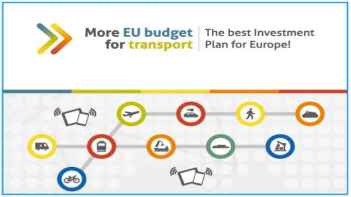More EU budget for transport: the best investment plan for Europe
09 June 2016
The Commission is preparing a mid-term review of the Multi-Annual Financial Framework (MFF) or the EU budget 2014-2020.
The Connecting Europe Facility which co-finances many transport infrastructure and innovation projects was been reduced from €33.2 to €30.4 billion last year further to the set-up of the European Fund for Strategic Investments (EFSI or Juncker Plan). The impact on transport was particularly hard: the loss amounted to €2.2 billion of potential grants or almost the equivalent of the co-financing budget necessary to resolve all critical sections in the EU waterway network.
Together with 25 transport associations, the inland waterway organisations Inland Navigation Europe, European Barge Union and European Skippers’Organisation urge the European Parliament and the Council to increase the Connecting Europe Facility (CEF) budget in the upcoming review of the Multi-Annual Financial Framework.
“The transport sector is not just asking for money. We are all asking for a strong multiplier for the EU backbone for trade and mobility that will create on its own 10 million additional jobs by 2030. We want to be able to exploit at the fullest the synergies between transport, energy and digitalisation to keep our continent at the forefront in the 21th century.
We ask the EU to fully apprehend that investment in transport is a pro-growth policy indispensable for our welfare and wellbeing. Many projects facing important financial gaps are not bankable and don’t attract private investors but provide strong societal return on investment which is crucial to help achieve the EU energy and climate goals. We must invest to make transport better, greener, cleaner and connect it in an increasingly competitive and digital world.”
The European Court of Auditors examined last year whether infrastructure projects co- funded by the EU contributed effectively to increase the modal share of inland waterway transport and helped in improving navigability conditions. The Court concluded that since shifting freight traffic from roads to the network of rivers and canals is beneficial to all EU, a connected Europe with a sustainable transport strategy requires greater effort to improve its waterways.
The inland waterway organisations are realistic. We know that TEN-T investment needs are more than tenfold the available EU CEF transport budget of €24.05 billion. The Juncker Plan is an attempt to draw in new investment, but let’s not only look whether projects match EFSI but look pragmatically and objectively whether EFSI matches the projects. No waterway infrastructure project is yet leveraging investment under the Juncker Plan (EFSI).
We have to look in all openness what blending mix of funding and financing makes projects possible and how we ensure that critical waterway bottlenecks are finally lifted. Inland waterways is the fastest growing transport mode after road transport. Keeping bottlenecks in place risks to undermine this positive development. That would result in more traffic jams and a less sustainability.
Joint call of transport organisations for more transport budget
Inland waterway transport by numbers
Background information on MFF



